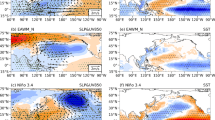Abstract
This paper presents the following data-based hypothesis on the mechanism of the EI Niño-Southern Oscillation (ENSO) cycle: during the warm phase of ENSO, there are weterly wind anomalies over the equatorial west-central Pacific and the sea surface temperature (SST) in the equatorial east-central Pacific is higher. The latter can strengthen Hadley circulation, and the west component of the Hadley circulation anomaly may cause southerly monsoon circulation. When the monsoon is a southerly anomaly, SST in the South China Sea (SCS) becomes higher. When the SCS gets warmer, the atmospheric convection will move to it, and then easterly anomaly wind will occur over the western Pacific. A cycle is completed. This hypothesis was used to construct an analogical oscillator model that produces ENSO-like oscillations. The negative feedback mechanism of the hypothesis is SST anomaly in the SCS. This negative feedback mechanism is quite different from others proposed before, is not within the Pacific and does not depend on ocean waves and their boundary reflection.
Similar content being viewed by others
References
Barnett, T. P., 1983. Interaction of monsoon and Pacific trade wind system at interannual time scales, Part I: the equatorial zone.Mon. Wea. Rev. 111: 756–773.
Barnett, T. P., 1984. Interaction of monsoon and Pacific trade wind system at interannual time scales, Part II: the tropical band.Mon. Wea. Rev. 112: 2380–2387.
Battist, D. S., Hirst, A. C., 1989. Interannual variability in a tropical atmosphere-ocean model: Influence of the basic state ocean geometry and nonlinearity.J. Atoms, Sci. 46: 1687–1712.
Bjerknes, J., 1966. A possible response of the atmospheric Hadley circulation to equatorial anomalies of ocean temperature.Tellus 18: 820–829.
Bjerknes, J., 1969. Atmospheric teleconnections from the equatorial Pacific.Mon. Wea. Rev. 97: 163–172.
McCreary, J. P., Anderson, D. L. T., 1991. An overview of coupled ocean-atmosphere models of El Niño and the southern oscillation.J. Geophys. Res. 96: 3125–3150.
Meehl, G. A., 1987. The annual cycle and internnual variability in the tropical Pacific and Indian Ocean regions.Mon. Wea. Rev. 115: 27–50.
Meehl, G. A., 1993. A coupled air-sea biennial mechanism, in the tropical Indian and Pacific regions: Role of the ocean.J. Climate 6: 31–41.
Rasmusson, E. M., Carpenter, T. H., 1982. variations in tropical sea surface temperature and surface wind fields associated with the southern oscillations/El Niño.Mon. Wea. Rev. 110: 354–384.
Shen, S., Lau, K. M., 1995. Biennial oscillation associated with the fast Asian summer monsoon and tropical sea surface temperature.J. Meteor. Soc. Japan 73: 105–124.
Suarez, M. J., Schopf, P. S., 1988. A delayed action oscillator for ENSO.J. Atmos. Sci. 44: 2418–2436.
Tomita, T., Yasunari, T., 1996. Role of the north-east winter monsoon on the biennial oscillations of the ENSO/monsoon system.J. Meteor. Soc. Japan 74: 339–413.
Tomoaki, O., Song, Y., Kitoh, A., 1997. Sea surface temperature in the South China Sea, an index for the Asian monsoon and ENSO system.J. Meteor. Soc. Japan 75: 1091–1107.
Webster, P. J., Yang, S., 1992. Monsoon and ENSO: selectively interactive systems.Q. J. R. Meteorol. Soc. 118: 877–926.
Weisberg, R. H., Wang, C., 1997. A western Pacific oscillator paradigm for the El Niño-Southern oscillation.Geophys. Res. Lett. 24: 779–782.
Yu Shenyu, Zhou Faxiu, Fu Gang et al., 1994. Basic feature of the SST low frequency oscillation in the South China Sea.Oceanol. Limnol. Sinica 125: 546–551. (in Chinese with English abstract)
Zhang, R. H., Sumi, A., Kimoto, M., 1996. Impact of El Niño on the east Asian monsoon, A diagnostic study of the 86/87 and 91/92 events.J. Meteor. Soc. Japan 74: 49–62.
Author information
Authors and Affiliations
Additional information
Project 49776286 supported by NSFC.
Rights and permissions
About this article
Cite this article
Qi, W., Qin-yu, L. & Zeng-hao, Q. An ENSO-like oscillation system. Chin. J. Ocean. Limnol. 17, 331–337 (1999). https://doi.org/10.1007/BF02842826
Received:
Accepted:
Issue Date:
DOI: https://doi.org/10.1007/BF02842826




